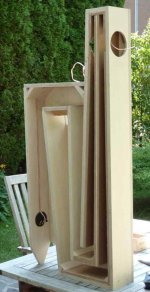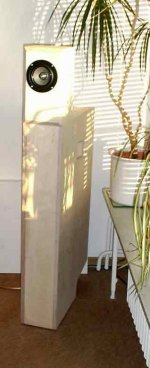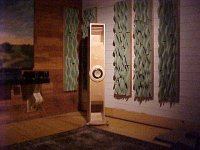I am new to full range speakers but need more efficient ones for my Cary 805s. After reading on various sites about the merits and drawbacks of various drivers and speaker box designs I am interested in the idea of combining the Horneshoppe's Model 3 use of multiple FE126en drivers in the larger 11 3/4" wide Nagaoka style Sachiko dual front loaded horn. I would like a wide and tall soundstage along with clear imaging. I want to initially try to avoid adding a super tweeter or sub to augment the sound. I understand that using multiple drivers will increase overall efficiency but I have the following questions:
1. Will using 2 horizontally placed or a 4 square pattern of drivers lessen the wonderful imaging I read is created by single point full range drivers.
2. Will using (4) 4" FE126en drivers in place of one 8" driver work well in the Sachiko Dual FLH? What problems may it create?
3. Is there any issue with using Enabled drivers in a multiple pattern?
4. How important are exact dimensions in horn designs? Will fractions of an inch make a listenable difference in the sound?
I do plan on including a removeable/replaceable speaker baffle to be able to try out different combinations. I understand that it is the combination of the drivers and box that make it work.
1. Will using 2 horizontally placed or a 4 square pattern of drivers lessen the wonderful imaging I read is created by single point full range drivers.
2. Will using (4) 4" FE126en drivers in place of one 8" driver work well in the Sachiko Dual FLH? What problems may it create?
3. Is there any issue with using Enabled drivers in a multiple pattern?
4. How important are exact dimensions in horn designs? Will fractions of an inch make a listenable difference in the sound?
I do plan on including a removeable/replaceable speaker baffle to be able to try out different combinations. I understand that it is the combination of the drivers and box that make it work.
I'm just wondering what special advantages you are hoping to obtain using 4 drivers the cabinet was not designed for instead of one that it was? Briefly
1/ Possibly. Possibly not. It's likely going to end up being circumstance & taste dependant.
2/ Sachiko is a back horn, not a front horn. It does not load the front of the driver. And no, they're not likely to work all that well; I'd anticipate a relative lack of gain on the bottom end.
3/ I don't think anyone's tried it.
4/ Very, and they can do, yes.
Indeed. A cabinet is designed for a specific drive unit, so if you drop something else into it, it's not going to perform as originally intended.
1/ Possibly. Possibly not. It's likely going to end up being circumstance & taste dependant.
2/ Sachiko is a back horn, not a front horn. It does not load the front of the driver. And no, they're not likely to work all that well; I'd anticipate a relative lack of gain on the bottom end.
3/ I don't think anyone's tried it.
4/ Very, and they can do, yes.
Indeed. A cabinet is designed for a specific drive unit, so if you drop something else into it, it's not going to perform as originally intended.
The reason for using the 4" sized drivers is that I have read they were the best balance between maintaning HF and still having enough LF. The reason for using 4 drivers would be (1) to achieve increased efficiency over the 93 db listed for the FE126en's, (2) to create a speaker with a large enough sound for a 28' x 22' room, and (3) be able to use the wider box which would be less likely to tip over.
On the Planet_10 website, the Spawn family plans page, the Sachiko is shown with the openings to the front of the speaker. I have assumed this was a front loaded design. There couold be other designs I don't know about.
If I was going to compare using a number of 4" drivers versus one 8" driver what parameters would I use to guide me? The surface area is very close to being the same but that is probably too simplistic. Obviously, actually building it and listening is the real test. I just want to be headed in the right direction for what I am attempting to accomplish.
On the Planet_10 website, the Spawn family plans page, the Sachiko is shown with the openings to the front of the speaker. I have assumed this was a front loaded design. There couold be other designs I don't know about.
If I was going to compare using a number of 4" drivers versus one 8" driver what parameters would I use to guide me? The surface area is very close to being the same but that is probably too simplistic. Obviously, actually building it and listening is the real test. I just want to be headed in the right direction for what I am attempting to accomplish.
Well, they have their upsides WRT the HF, although that is tempered by their relative losses on the bottom end. Re your numbered points,
1/ You'll get +6dB over 1 FE126En using four drivers, assuming series-parallel wiring. That's theoretically a little more than 1 FE206E, although the efficiency of the 126 is in practice a little over-rated, so they'll be much of a muchness in that sense.
2/ You'd get that with the driver it was designed for in the first place
3/ Ditto.
No. A front horn is what it sounds like: a horn attached to the front of the driver. Sachiko is a back horn -the horn is attached to the rear of the driver. I happen to know this enclosure rather well because I designed it. 😉
You'll need to have drivers with a similar total Q, combined Vas, Re and BxL similar to the design unit (Fostex FE206E) once you've accounted for the manner in which you wire them.
1/ You'll get +6dB over 1 FE126En using four drivers, assuming series-parallel wiring. That's theoretically a little more than 1 FE206E, although the efficiency of the 126 is in practice a little over-rated, so they'll be much of a muchness in that sense.
2/ You'd get that with the driver it was designed for in the first place
3/ Ditto.
No. A front horn is what it sounds like: a horn attached to the front of the driver. Sachiko is a back horn -the horn is attached to the rear of the driver. I happen to know this enclosure rather well because I designed it. 😉
You'll need to have drivers with a similar total Q, combined Vas, Re and BxL similar to the design unit (Fostex FE206E) once you've accounted for the manner in which you wire them.
Last edited:
of course you could always stack 4 smaller BLH (either rear or front mouth) - one pair side to side and the other pair flipped on top - that I know as been done 🙂
the most number of EnAbled FR drivers that I'm aware of being tried in a single enclosure was 2xFF85K in a stretched uFonken
as the oft raised "issues" of sensitivity and playing levels, perhaps it's my approaching 60yr old aesthetic, but just how freaking loud do you need to listen? and all theoretical calculations of clipping-free power required to achieve same aside, consider the following - courtesy of Sjaran Ebaen at moons
If your speaker placement can accommodate a rear mouthed design, it might be worth taking a look at Scott's Valiant for the FE126En - one of the better enclosures of quite of few in which I've heard this driver
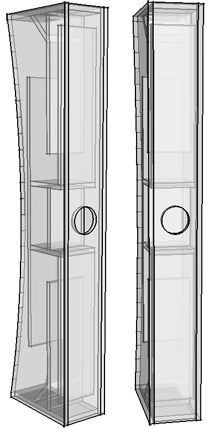
and there are lots of ways to keep a tall skinny speaker from tipping over
the most number of EnAbled FR drivers that I'm aware of being tried in a single enclosure was 2xFF85K in a stretched uFonken
as the oft raised "issues" of sensitivity and playing levels, perhaps it's my approaching 60yr old aesthetic, but just how freaking loud do you need to listen? and all theoretical calculations of clipping-free power required to achieve same aside, consider the following - courtesy of Sjaran Ebaen at moons
of course none of the equipment he's referencing are DIY type or budget, but I kinda think the highlighted comments are applicable for much of our real world listening** A recent Swiss wine & cheese presentation by Nagra Audio, of their new 300p amplifier in a sizeable hall of Château d'Aigle with Verity Audio speakers, showed their amp's modulometer at 0.2-watt output with 2-watt peaks when playback levels of a Jacques Loussier Mozart Piano Concerto N°. 20 were just right. While Yamamoto's 3-watt rating does impose obvious restrictions in speaker choices, most consumers are sadly misinformed about their actual power requirements. Combine the A-010's circuit gain with a hi-gain source like my 5.5V-max Weiss DAC2 for example and you could do serious damage with even standard 90dB speakers and a passive preamp. Granted, loudness alone never equates with optimum drive and control. Particularly low-frequency peaks should cause clipping over most regular speakers whilst running a no-feedback SET to its power limits will seriously increase its harmonic distortion. Even so, common concerns that such amps can't play loud enough unless one had 110dB horns, tiny rooms or only played string quartet adagios are somewhat irrational.
If your speaker placement can accommodate a rear mouthed design, it might be worth taking a look at Scott's Valiant for the FE126En - one of the better enclosures of quite of few in which I've heard this driver

and there are lots of ways to keep a tall skinny speaker from tipping over
Last edited:
True. That said, you can never have too much headroom 😀  However, if 4 x FE126En are required, then the horn really does need to be designed with this in mind, whether for 4 units, or individual horns then grouped together.
However, if 4 x FE126En are required, then the horn really does need to be designed with this in mind, whether for 4 units, or individual horns then grouped together.
 However, if 4 x FE126En are required, then the horn really does need to be designed with this in mind, whether for 4 units, or individual horns then grouped together.
However, if 4 x FE126En are required, then the horn really does need to be designed with this in mind, whether for 4 units, or individual horns then grouped together.If you want to build Sachiko, you should use the 8" driver for which is was designed. If you want to use a 4" driver, you should build Saburo* instead. If you want twice as much output you should build two pair Saburo. You could probably construct two Saburo cabinets as Siamese twins, sharing a common center wall.
* or one of the newer spawn designs for the 4" drivers
* or one of the newer spawn designs for the 4" drivers
Last edited:
True. That said, you can never have too much headroom 😀However, if 4 x FE126En are required, then the horn really does need to be designed with this in mind, whether for 4 units, or individual horns then grouped together.
why spend the time properly engineering a design when the hillbilly brute force approach can work well enough for many a refined listener?
meow
It would appear that mberrync may not yet have heard a commercial or DIY "fullrange" speaker with the FE126E (perhaps any?) driver. Until such time, it may be premature for him to assume that a single wouldn't be enough.
Of course, now that I more carefully read the thread, his room might well benefit from a well executed design for a single larger driver (such as the FE166) as opposed to multiples of smaller. Unless there are some serious placement restrictions not yet described, I'd guess that average listening distance could be far enough that integration of the dual front mouth designs, which applies for any size driver, wouldn't be a big problem.
The question of "scalability" of this type of speaker often arises, and while there's a lot more work involved in recalculating the math than in revising the material cut sheets, I've built / heard enough of Scott's designs to appreciate that he has a pretty good handle on the former, making it a lot easier for guys like me to accomplish the latter.
Last edited:
Chris, Scott, & I have had conversations about something akin to the EdHorn Model 3. Usually along the lines of merging 4 Frugel-Horns together. I would not be surprised in a visual of this inside Scott's head influenced the creation of Maeshowe and subsequently Valiant, Victor, & Vulcan, which by using a single driver, avoid the theoretical disadvantages in terms of imaging, HF, and general cohesiveness of multiple drivers running full-range.
My objections, based soley on theory, to multiple drivers, started breaking down when Bob brought over a set of Twin EL70 in a BR box. Even with the drivers spaced further apart than possible, once in the farfield i could not detect any of the theoretical issues. This (+ discussions with Cal about 4 in a line) lead to the Twin uFonken with a pair of FF85 per box. They work fine too. The latest practical example has been Colin's build of a Twin Mar-Ken10 with 2 1st gen Alpair10. In theory, this should not work at all, but, recently at EggFest, Scott reports that despite other issues, none of the theoretical objections surfaced. And the enthusuastic reviews of the Model 3 stand on top of those. MotoSapien's recent Coniston^2 experience tempers those results.
I have secretly been hoping someone brave enuff (and deep enuff of wallet) would come along and try this -- my drivers or anyone elses, althou EnABLed drivers should have an advantage in combatting the theoretical disadvantages. It would certainly have huge dynamic capability and wall or corner loaded, the size of the effective horn would be large enuff to get trie horn load way down. A big room with a listening position in the farfield would be the ideal venue, and even a "huge power house" like an SE45 should be capable of hearing damaging levels. With your SE805, you should never get out of idle (using measured numbers for FE126eN^2 efficiency should be ~98.5-98.75 dB).
And a very dramatic & interesting looking box. (here a quick sketch)
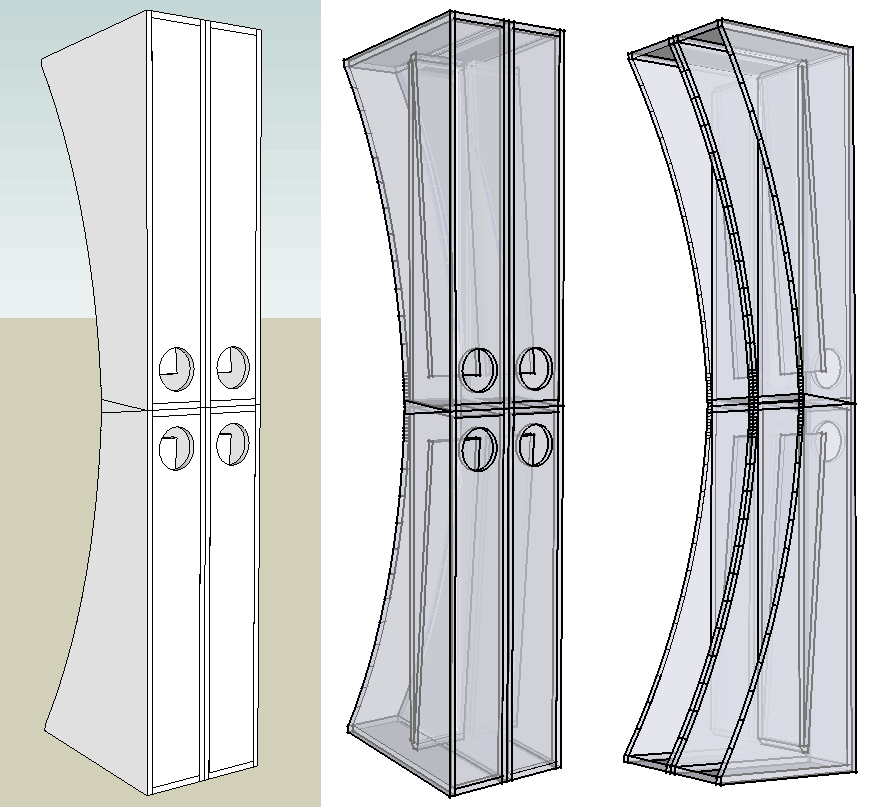
The safe way to approact this would be to build 4 pair (of slightly modified, i can do that) FH3, and then joing them mechanically with a common baffle and some strategically placed screws. If it does't work out, one can dissassemble, redo the removable baffles and have 4 pair of Frugel-Horns. If it works, one would consider a unified build (you could get the drivers closer together by a bit) or just finish the amalgum so that it looks like a single box.
I would encourage you to blaze a trail. I'm happy to help as i can.
BTW: i did up a set of 8 FE126eN for a set of Model 3s -- and they aren't all that far away from you (assumming nc stands for North Carolina)
dave
My objections, based soley on theory, to multiple drivers, started breaking down when Bob brought over a set of Twin EL70 in a BR box. Even with the drivers spaced further apart than possible, once in the farfield i could not detect any of the theoretical issues. This (+ discussions with Cal about 4 in a line) lead to the Twin uFonken with a pair of FF85 per box. They work fine too. The latest practical example has been Colin's build of a Twin Mar-Ken10 with 2 1st gen Alpair10. In theory, this should not work at all, but, recently at EggFest, Scott reports that despite other issues, none of the theoretical objections surfaced. And the enthusuastic reviews of the Model 3 stand on top of those. MotoSapien's recent Coniston^2 experience tempers those results.
I have secretly been hoping someone brave enuff (and deep enuff of wallet) would come along and try this -- my drivers or anyone elses, althou EnABLed drivers should have an advantage in combatting the theoretical disadvantages. It would certainly have huge dynamic capability and wall or corner loaded, the size of the effective horn would be large enuff to get trie horn load way down. A big room with a listening position in the farfield would be the ideal venue, and even a "huge power house" like an SE45 should be capable of hearing damaging levels. With your SE805, you should never get out of idle (using measured numbers for FE126eN^2 efficiency should be ~98.5-98.75 dB).
And a very dramatic & interesting looking box. (here a quick sketch)

The safe way to approact this would be to build 4 pair (of slightly modified, i can do that) FH3, and then joing them mechanically with a common baffle and some strategically placed screws. If it does't work out, one can dissassemble, redo the removable baffles and have 4 pair of Frugel-Horns. If it works, one would consider a unified build (you could get the drivers closer together by a bit) or just finish the amalgum so that it looks like a single box.
I would encourage you to blaze a trail. I'm happy to help as i can.
BTW: i did up a set of 8 FE126eN for a set of Model 3s -- and they aren't all that far away from you (assumming nc stands for North Carolina)
dave
Probably time for mberry to pipe in regarding any room placement issues, and for that matter any listening experience with FR designs to date.
Larger scale horn designs of either the front or rear mouth discussed so for each have their own requirements.
Larger scale horn designs of either the front or rear mouth discussed so for each have their own requirements.
I greatly appreciate the replys and information from those with so much experience. It makes sense but will take a while to process. I should have picked up on the FLH versus BLH. None of the posts places I had read ever said front mouth or rear mouth but have certainly seen speakers like the Avantgardes and should have figured it out.
Yes, I have yet to hear a full range speaker although i have ordered a pair of FE126en's to try them out. I have only had Paradigm speakers the latest being modified Studio 100 v2's (89 or 90 SPL with 3 ohm dip) with the HF crossover parts changed out with all film and foil caps and better resistors, etc. and the tweeters changed out with Scanspeak d2905/9500's. All this has made them much smoother. My previous amp was a Rotel 500w class D RMB-1092. Needless to say a lot more power than the current 50 watt (25w class A) Cary CAD 805 AE. CD player is a tubed Raysonic 128 with Orange Globe tubes and Cary SLP-05 Preamp. Zu Varial interconnects and Wax speaker cables. Being in Charlotte NC I don't have the opportunity to try out much equipment prior to purchase.
Room is 28' x 22' (over garage), 9 ' ceiling with 8" deep wood beams in 9 square pattern, speakers have to be on long wall. Speakers are now 14' center to center, 12' from first listening spot and 16' from second spot at desk behind sofa. Speakers now 3 or 4 feet from wall . First reflection locations on floor, wall, ceiling have absorptive materials. Sofa and 2 loveseats in U shape.
My first reason for looking at full range speakers is mismatch of tube amp with low efficiency speakers. I have read higher efficiency speakers have more dynamics so as typical I want to try the extreme. Hearing more at lower levels would be a plus.
I have gravated toward the front mouth Sachiko design because of a desire for both a tall and wide soundstage. I have assumed that a front mouth design can be located closer to the wall although you have to sit farther away (rear mouth being opposite). A review on Audiogon said the soundstage got deeper as they were moved closer to the wall. The ideal speaker position in my room would be against the wall 20 feet apart with the listening positions at 16 feet and 20 feet away. Against the wall would be prefered by the wife especaily if they are 6 feet tall. Is this possible? Again, understand trying is only way to know.
Yes, I have yet to hear a full range speaker although i have ordered a pair of FE126en's to try them out. I have only had Paradigm speakers the latest being modified Studio 100 v2's (89 or 90 SPL with 3 ohm dip) with the HF crossover parts changed out with all film and foil caps and better resistors, etc. and the tweeters changed out with Scanspeak d2905/9500's. All this has made them much smoother. My previous amp was a Rotel 500w class D RMB-1092. Needless to say a lot more power than the current 50 watt (25w class A) Cary CAD 805 AE. CD player is a tubed Raysonic 128 with Orange Globe tubes and Cary SLP-05 Preamp. Zu Varial interconnects and Wax speaker cables. Being in Charlotte NC I don't have the opportunity to try out much equipment prior to purchase.
Room is 28' x 22' (over garage), 9 ' ceiling with 8" deep wood beams in 9 square pattern, speakers have to be on long wall. Speakers are now 14' center to center, 12' from first listening spot and 16' from second spot at desk behind sofa. Speakers now 3 or 4 feet from wall . First reflection locations on floor, wall, ceiling have absorptive materials. Sofa and 2 loveseats in U shape.
My first reason for looking at full range speakers is mismatch of tube amp with low efficiency speakers. I have read higher efficiency speakers have more dynamics so as typical I want to try the extreme. Hearing more at lower levels would be a plus.
I have gravated toward the front mouth Sachiko design because of a desire for both a tall and wide soundstage. I have assumed that a front mouth design can be located closer to the wall although you have to sit farther away (rear mouth being opposite). A review on Audiogon said the soundstage got deeper as they were moved closer to the wall. The ideal speaker position in my room would be against the wall 20 feet apart with the listening positions at 16 feet and 20 feet away. Against the wall would be prefered by the wife especaily if they are 6 feet tall. Is this possible? Again, understand trying is only way to know.
First reflection locations on wall... wide soundstage. I have assumed that a front mouth design can be located closer to the wall although you have to sit farther away (rear mouth being opposite).
You might want to try removing damping at the 1st reflection, Toole found that it is helpful for improving soundstage.
Rear mouths are usually designed to take advantage of placement close to wall (or corner), Sachiko in particular likes to be out from the wall. And if Saburo vrs Valiant is any indication, you might well want to looks at Vulcan instead of Sachiko. Certainly look at Valiant for the FE126En. That will give you a really good idea of where you want to go.
dave
Where can i see the Vulcan and Valiant designs. I did not see those specific names on the Spawn Family plans page. Are they called something else on the plans page?
I found that sound clarity and imaging improved once I damped the first reflections. It did make the sound not as lively which probably hurt the feeling of spaciousness.
It's too bad there always are trade offs and decisions to be made about what is more important when everything wants to be.
I found that sound clarity and imaging improved once I damped the first reflections. It did make the sound not as lively which probably hurt the feeling of spaciousness.
It's too bad there always are trade offs and decisions to be made about what is more important when everything wants to be.
I have assumed that a front mouth design can be located closer to the wall although you have to sit farther away (rear mouth being opposite).
It depends on the cabinet design in question. Typically those with a rear facing mouth are intended to be used near room boundaries.
I found that sound clarity and imaging improved once I damped the first reflections. It did make the sound not as lively which probably hurt the feeling of spaciousness. It's too bad there always are trade offs and decisions to be made about what is more important when everything wants to be.
Then you could try dispersing them rather than damping. E.g.
Attachments
....
If your speaker placement can accommodate a rear mouthed design, it might be worth taking a look at Scott's Valiant for the FE126En - one of the better enclosures of quite of few in which I've heard this driver ...
Can I ask how these speakers need to be placed? They look like something I might be able to use. I'd like to use Fostex FE126En drivers
Here is what I'm doing....
I'm building a small tube amp with parts I've collected from salvage. I found two small output transformers suitable for about 4W of power if I keep bass at about 50Hz. I'm using 6BQ5 (EL84) tube as triodes in push pull. I don't get much power this way but Spice simulation is telling me I can have THD 0.25% with no global feedback. I doubt that number is right but we need not care here, the point is the amp will be low power, low distortion with bass to about 50Hz.
This will be a bedroom system played at low volume. The room is 13 x 16 feet with a tall cathedral ceiling, speakers will have to go near the center of the long wall, maybe 6 feet apart. They need to be tall, up to about shoulder height floor standing. Tall but "low bulk" meaning narrow. The goal is to "fill the room with sound" rather than have good imaging at a small "sweet spot"
Are these what I want or something else? I was thinking also of an upward facing horn as the ceiling raises at about a 30 degree angle
Can I ask how these speakers need to be placed? They look like something I might be able to use. I'd like to use Fostex FE126En drivers
Here is what I'm doing....
I'm building a small tube amp with parts I've collected from salvage. I found two small output transformers suitable for about 4W of power if I keep bass at about 50Hz. I'm using 6BQ5 (EL84) tube as triodes in push pull. I don't get much power this way but Spice simulation is telling me I can have THD 0.25% with no global feedback. I doubt that number is right but we need not care here, the point is the amp will be low power, low distortion with bass to about 50Hz.
This will be a bedroom system played at low volume. The room is 13 x 16 feet with a tall cathedral ceiling, speakers will have to go near the center of the long wall, maybe 6 feet apart. They need to be tall, up to about shoulder height floor standing. Tall but "low bulk" meaning narrow. The goal is to "fill the room with sound" rather than have good imaging at a small "sweet spot"
Are these what I want or something else? I was thinking also of an upward facing horn as the ceiling raises at about a 30 degree angle
With a rear mouth BLH design such as we're talking about, the quantity and quality of bass will vary the most depending on placement. In my own experience with FE126 in these types, I've found the "sweet spot" in terms of bass performance and imaging when the enclosures were located as symmetrically as possible in proximity to corner ( anywhere from 1 -3 feet from the apex ), and toed in to cross slightly in front of the average listening position. The "little" FH3, with its 5` tilted front baffle does a surprisingly good job of big soundstage from a relatively small enclosure - the Woden Valiant (which I previously referred to as Maeshowe) will fill an even larger venue, but at 60" height might be taller than you want.
The proposed amp project you have in mind would be ideal for this application. I have one myself* that after well more than 5yrs is still a daily driver.
*variation on Eli Duttman/Jim McShane's El Cheapo design - CCS biased 12AT7 LTP driving EL84 in triode mode (NFB). If you're using "real" 6BQ5s with internally isolated suppressor grids, you might also want to experiment with the Hazen grid mod. I quite like what it does, and it only costs one cheap film cap per output tube.
- Status
- Not open for further replies.
- Home
- Loudspeakers
- Full Range
- Large Dual FLH with multiple ENabled FE126en drivers
